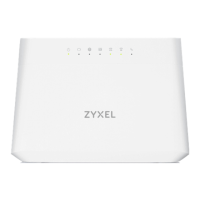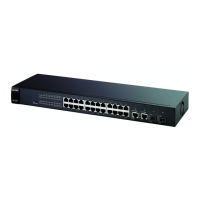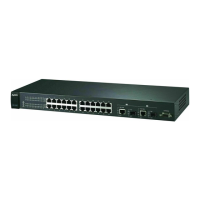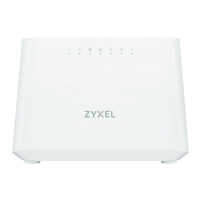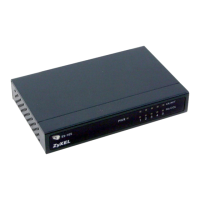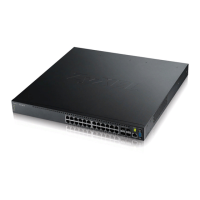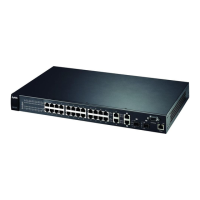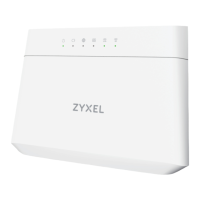
Do you have a question about the ZyXEL Communications EMG3525-T50B and is the answer not in the manual?
| Device Type | Wireless Router |
|---|---|
| Wireless Standards | 802.11a/b/g/n/ac |
| Frequency Bands | 2.4 GHz, 5 GHz |
| USB Ports | 1 x USB 2.0 |
| Wireless Data Rate | 300 Mbps (2.4 GHz), 867 Mbps (5 GHz) |
| Power Supply | 12V DC, 1.5A |
| Operating Temperature | 0°C to 40°C |
| WAN Ports | 1 x 10/100/1000 Mbps |
| LAN Ports | 4 x Gigabit Ethernet |
| Security | WPA, WPA2, WEP |
| Weight | 0.5 kg |
| Humidity | 10% to 90% (non-condensing) |
| Storage Temperature | -20°C to 70°C |
Explains how warnings and notes are displayed in the guide. Warnings highlight potential harm to users or the Zyxel Device.
Details conventions for product labels, screen names, field labels, and choices, including the use of angle brackets for mouse clicks.
Lists generic icons used in the guide, noting that the Zyxel Device icon is not an exact representation.
Introduces the Zyxel Device series and lists supported models, providing a comparison table for features.
Illustrates Zyxel Device usage in various network environments, covering Internet access, firewall, WiFi, and USB applications.
Explains how to configure Internet access via DSL, G.fast, Ethernet WAN, and Fiber connections for different Zyxel Device series.
Describes how to configure the firewall for secure Internet access, blocking incoming traffic by default unless initiated from the network.
Details how the Zyxel Device functions as an Access Point (AP) for WiFi clients and supports WPS for quick setup.
Explains how the Zyxel Device supports 'triple play' services like VoIP, streaming video, and audio simultaneously.
Covers USB port usage for cellular WAN backup, file sharing, and media server functionalities.
Provides recommendations for enhancing Zyxel Device security and effective management, including password changes and backups.
Explains how to use LEDs to determine the Zyxel Device's operational status and identify network problems.
Describes the physical ports and buttons on the Zyxel Device's panels, including SFP transceiver installation and removal.
Details the installation and removal procedures for SFP transceivers used to connect Ethernet or fiber optic cables.
Explains how to activate the WiFi function and use WPS for quick, secure wireless connection setup.
Provides instructions on using the RESET button to restore factory default settings, useful for forgotten passwords or configuration issues.
Details the procedure for wall mounting the Zyxel Device, including drilling and screw placement for secure attachment.
Introduces the Web Configurator as an HTML-based interface for system setup and management via web browser.
Provides step-by-step instructions on how to access the Web Configurator, including connecting hardware and launching a web browser.
Explains the main screen layout of the Web Configurator, dividing it into sections like Settings Icon, Layout Icon, and Main Window.
Describes the Settings Icon, which opens the side bar and navigation panel for accessing device configurations.
Details the icons available in the side bar, such as Wizard, Theme, Restart, Language, Help, and Logout functions.
Introduces the Wizard screens for configuring the Zyxel Device's time zone and WiFi settings.
Guides users through the Quick Start Wizard, allowing them to proceed with time zone and WiFi settings or skip the process.
Instructs users to select the Zyxel Device's location time zone and proceed to the next step.
Explains how the Zyxel Device detects the Internet connection status and guides the user to continue or troubleshoot.
Confirms that the Zyxel Device has successfully established an Internet connection.
Provides guidance for troubleshooting when the Zyxel Device fails to detect a WAN connection.
Guides users on configuring WiFi settings, including recording the WiFi Name and Password, and managing visibility.
Confirms that the Zyxel Device saves and applies the configured settings.
Provides an overview of the Zyxel Device's features accessible through the web interface.
Details setting up DSL or Ethernet Internet connections, including Routing and Bridge modes.
Tutorial for setting up a DSL Internet connection using the Web Configurator on DSL routers.
Explains how to configure an Ethernet WAN connection by connecting a broadband modem/router to the Zyxel Device's WAN port.
Guides users on setting up a WiFi network, acting as an access point for WiFi clients.
Demonstrates changing default WiFi security settings to WPA2-PSK for improved security.
Details connecting WiFi devices using WPS for secure setup without manual password entry.
Explains the Push Button Configuration (PBC) method for connecting WiFi devices via WPS.
Describes the WPS PIN Configuration method, a more secure WPS version for WiFi-enabled devices.
Guides on creating two WiFi networks (e.g., General and Guest) with different SSIDs and security modes.
Details setting up two guest WiFi networks (Guest and VIP) on different bands (2.4GHz and 5GHz) with unique SSIDs.
Covers setting up cellular backup, accessing shared folders, and playing media files using a USB device.
Explains how to connect to the Internet via a cellular dongle for a backup WAN connection.
Guides on creating shared folders on the Zyxel Device via USB and allowing network access.
Provides steps for setting up shared folders on the Zyxel Device before enabling file sharing.
Explains how to access USB storage devices via Windows Explorer using shared files.
Details how to use the media server feature to play files on computers or televisions.
Provides steps to configure the Zyxel Device as a media server for DLNA-compliant clients.
Guides on playing media files from the USB device using Windows Media Player.
Explains how to use the Zyxel Device with a hardware digital media player to play stored media files on a TV.
Describes how to use an FTP program to access files on a USB storage device connected to the Zyxel Device.
Covers configuring Firewall rules, Parental Control, and MAC Filter rules for network security.
Explains how to enable the firewall to protect LAN computers from Internet attacks and configure rules.
Guides on configuring rules for accessing the Internet using parental controls, including schedules and URL filtering.
Details setting up rules for Internet usage scheduling and blocking websites with specific URLs or keywords.
Explains how to set up a schedule rule for Internet usage, limiting days and times for user access.
Describes using a MAC address filter to allow or permanently block access for wired LAN clients.
Provides instructions on making Internet calls using VoIP technology.
Guides on setting up a SIP account with a provider and configuring the Zyxel Device for VoIP calls.
Details the process of adding a SIP service provider's information for VoIP configuration.
Explains how to set up a SIP account and map it to a phone port for making and receiving VoIP calls.
Guides on configuring phone ports to use SIP accounts for making and receiving calls.
Provides steps for making a phone call using Voice over IP (VoIP) technology.
Covers upgrading firmware, backing up configuration, and restoring Zyxel Device settings.
Explains how to upload new firmware to the Zyxel Device for feature enhancements.
Guides on backing up the Zyxel Device's current configuration to a file on your computer.
Details how to upload a previously saved configuration file from your computer to your Zyxel Device.
Introduces how to use the MPro Mesh app to manage the Zyxel Device and MPro Mesh network.
Lists the capabilities of the MPro Mesh app, including network controller decisions and setup procedures.
Explains the MPro Mesh network, requiring a router and at least one extender for expanded WiFi coverage.
Details connecting MPro Mesh Router/Extender with WiFi or wired connections, and non-MPro Mesh Router with Extender.
Guides on enabling MPro Mesh on both the router and extender, noting it's enabled by default.
Provides steps to set up an MPro Mesh Router with an MPro Mesh Extender using WiFi or wired connection.
Describes setting up an MPro Mesh network with a wired connection from a non-MPro Mesh router to extenders.
Explains how to check signal icons to find optimal placement for extenders to improve WiFi signal.
Shows how to view Zyxel Devices connected in an MPro Mesh network and their status.
Advises changing default WiFi settings for better security and reconnecting devices with new settings.
Guides on sharing QR codes for WiFi clients to connect to the Zyxel Device's Home WiFi network.
Explains using Parental Control to create schedule profiles limiting client Internet access by day and time.
Details how to view connected clients on the MPro Mesh network, their link quality, and device details.
Guides on changing client device names displayed within the app for better identification.
Explains how to block specific clients from Internet access immediately using the Pause Internet function.
Guides on setting up a Guest WiFi network for different user groups, with unique SSIDs and passwords.
Explains how to share Guest WiFi QR codes, allowing clients to access only the Internet, not the internal network.
Describes how to access app information like online help, version, and privacy policy.
Provides steps to log out of the current Controller device (MPro Mesh router or extender) from the app.
Overview of the Connection Status screen, used for configuring Internet, WiFi, and parental control settings.
Explains how to view network connection status of the Zyxel Device and its connected clients.
Guides on selecting icons, entering device names, and enabling Internet Blocking for WiFi clients.
Checks if control services like HTTP or Telnet are allowed on interfaces (LAN/WAN/Trust Domain).
Displays basic system information about the Zyxel Device, including model, firmware, and network details.
Describes enabling/disabling the main WiFi network, checking SSIDs, and managing passwords.
Guides on enabling/disabling guest WiFi networks (2.4/5/6GHz), checking SSIDs, and managing passwords.
Explains how to view LAN IP address, subnet mask, and DHCP settings, and toggle the DHCP server.
Details viewing parental control profiles and adding new ones for restricted access schedules and URL filtering.
Guides on creating a parental control profile by adding devices and blocking Internet access based on schedules.
Explains how to define time periods and days for blocking Internet access on profile devices.
Discusses Broadband screens for configuring Zyxel Device for Internet access and WAN interfaces.
Outlines chapter content: managing WAN interfaces, cellular backup, advanced settings, and Ethernet WAN configuration.
Explains key terms and concepts for broadband settings, including WAN IP address, ATM, and PTM.
Advises users to obtain Internet access settings like encapsulation and WAN IP address from their ISP.
Guides on changing Zyxel Device's Internet access settings and viewing configured WAN services.
Details adding or editing WAN connections, with screens varying by interface type, mode, and encapsulation.
Explains Routing mode for sharing one IP address among multiple computers, requiring NAT and other features.
Describes Bridge mode for passing ISP-assigned IP addresses directly to devices, disabling routing functions.
Covers using a cellular dongle for a backup WAN connection, including configuration and budget setup.
Explains enabling/disabling ADSL over PTM, Annex M, DSL PhyR, and SRA functions for DSL line optimization.
Details configuring the fourth LAN port as an Ethernet WAN port for Internet access.
Provides additional technical background on topics like Encapsulation, IP over Ethernet, PPP over ATM, and PPPoE.
Introduces the Network Setting > Wireless screens for setting up WiFi networks and security.
Lists the Wireless screens and their functions, including General, Guest/More AP, MAC Authentication, and WPS.
Explains Wireless Basics, covering radio communication, standards, and data encryption methods.
Guides on enabling WiFi, setting SSID, and selecting security mode, recommending WPA3-SAE for encryption.
Allows wireless stations to connect without data encryption or authentication, making the network accessible to any device.
Recommends WPA2-PSK security mode for improved data encryption and user authentication.
Enables configuration of guest WiFi networks, allowing multiple SSIDs and varying security types per access point.
Guides on creating Guest and additional WiFi networks with different security settings.
Allows exclusive access or denial for wired LAN clients based on their MAC addresses.
Details configuring WiFi Protected Setup (WPS) for quick and secure WiFi network setup.
Explains enabling WiFi MultiMedia (WMM) and WMM Automatic Power Save Delivery (APSD) for enhanced data quality.
Covers advanced WiFi settings like additional security, power saving, and data transmission settings.
Allows scanning for WiFi channel noise and viewing results, indicating AP counts per channel.
Enables creating rules to schedule times for permitting Internet traffic from WiFi interfaces.
Guides on adding or editing WLAN scheduler rules, specifying SSID, days, time, and description.
Explains MPro Mesh support for managing WiFi networks, including AP steering and band steering.
Guides on enabling or disabling MPro Mesh on the Zyxel Device for network optimization.
Provides in-depth technical information on WiFi networks, terms, and concepts.
Explains WiFi networks, consisting of clients, access points, and bridges.
Defines common WiFi network terms and acronyms used in the Zyxel Device's Web Configurator.
Discusses WiFi security importance, standards, authentication, and encryption methods.
Explains SSID broadcasting, hiding, and recommendations for changing the default SSID.
Details using the MAC address filter to control device access to the WiFi network.
Describes how WiFi networks use encryption to protect information sent over the network.
Discusses limitations of WiFi signals, including distance, interference, and absorption.
Defines Basic Service Set (BSS) and Intra-BSS traffic, explaining communication between WiFi clients.
Explains MBSSID function for using one access point to provide multiple BSSs simultaneously.
Provides notes on multiple BSSs, including maximum BSSs per AP, key usage, and MBSSID conjunction with 802.1x.
Explains preamble types (short and long) used for signaling data transmission and their impact on performance.
Details the WPS standard for quick, secure WiFi network setup using push button or PIN methods.
Guides on using the WPS Push Button Configuration (PBC) method for automatic device connection.
Describes the WPS PIN Configuration method for secure WiFi setup using a unique Personal Identification Number.
Illustrates security settings distribution in a sample WPS setup with AP and client roles.
Highlights WPS limitations, including device-to-device operation, WPS-enabled requirement, and potential security risks.
Introduces Local Area Network (LAN) and its role in shared communication systems.
Lists chapter features: LAN setup, Static DHCP, UPnP, Additional Subnet, STB Vendor ID, Wake on LAN, and TFTP Server.
Explains key terms and concepts for home networking, including LAN, Subnet Mask, DHCP, DNS, and RADVD.
Explains IP Address, Subnet Mask, DHCP, DNS, and RADVD in the context of LAN.
Details how to identify UPnP hardware and explains NAT Traversal's automated network configuration.
Advises users to find MAC addresses of network devices for DHCP Client List setup.
Guides on setting the Local Area Network IP address, subnet mask, and configuring DHCP settings.
Explains how to assign fixed IP addresses to LAN clients based on their MAC addresses.
Instructs users to find MAC addresses of network devices for Static DHCP screen setup.
Guides on configuring UPnP settings for simplified peer-to-peer network connectivity.
Explains how to configure IP alias and public static IP to partition a physical network into logical networks.
Details configuring Vendor IDs of connected Set Top Boxes (STBs) for automatic static DHCP entries.
Explains how to remotely turn on network devices using Wake on LAN (WoL) with Magic Packet.
Guides on identifying a TFTP server for configuration file download using DHCP option 66.
Provides technical background on LANs, WANs, DHCP setup, DNS Server addresses, and LAN TCP/IP.
Explains DHCP configuration, allowing clients to obtain TCP/IP settings or disabling the server.
Details how DNS maps domain names to IP addresses and the importance of DNS server addresses.
Explains LAN IP address and subnet mask, and how the Zyxel Device assigns IP and DNS server addresses.
Demonstrates using the UPnP feature in Windows 10 to access the Zyxel Device.
Guides on ensuring UPnP is activated on both Zyxel Device and computer for auto-discovery.
Explains how the Zyxel Device uses default gateway and static routes for outbound traffic.
Guides on viewing and configuring static route rules to save time and bandwidth for LAN devices.
Details adding or editing static routes, requiring configuration of required information for the route.
Provides a tutorial on configuring static routing rules to route traffic between two department networks.
Guides on viewing and configuring DNS routes to forward DNS queries to specific WAN interfaces.
Explains how to manually add or edit Zyxel Device's DNS name and IP address entries.
Allows overriding default routing by routing packets based on criteria like source address.
Guides on configuring required information for a policy route, specifying parameters like source IP and protocol.
Explains Routing Information Protocol (RIP) for exchanging routing information with other routers.
Details opening the RIP screen to select RIP version and operation for WAN interfaces.
Explains QoS for delivering data with minimum delay and managing bandwidth for real-time multimedia.
Lists chapter features: General screen for QoS/bandwidth, Queue Setup, Classification Setup, Shaper Setup, and Policer Setup.
Provides terms and concepts to help understand Quality of Service (QoS).
Guides on enabling/disabling QoS and setting upstream bandwidth or traffic priority.
Allows configuration of QoS queue assignment to prioritize traffic on WAN or LAN interfaces.
Details adding or editing a QoS queue, selecting scheduling methods like SP, WRR, or SP+WRR.
Guides on adding, editing, or deleting QoS classifiers to group traffic by criteria like source address or port.
Explains adding or editing QoS classes, configuring criteria for data flow classification.
Allows using token bucket algorithm to control traffic bursts and maintain average rates.
Details adding or editing a QoS shaper, configuring interface and rate limit for traffic bursts.
Guides on viewing QoS policers to limit incoming traffic rates and apply actions like drop or modify.
Explains adding or editing QoS policers, configuring meter type, rates, and actions for traffic control.
Provides technical background on QoS, including IEEE 802.1Q Tag, DiffServ, IP Precedence, and Queue Assignment.
Defines NAT as IP address translation for packets between networks.
Lists NAT functionalities: Port Forwarding, Port Triggering, DMZ, ALG, Address Mapping, and Sessions.
Explains key terms for NAT, including Inside/Outside and Global/Local addresses, and the basic function of NAT.
Guides on forwarding incoming service requests from the Internet to servers on the local network.
Details the Port Forwarding screen for configuring rules to forward incoming service requests.
Explains creating or editing port forwarding rules by specifying ports, server IP, and protocol.
Describes trigger port forwarding, allowing LAN computers to dynamically use services by recording IP and port.
Guides on creating new port triggering rules, configuring ports and protocols for requests and responses.
Explains specifying a default server's IP address to receive packets not covered by Port Triggering.
Covers enabling/disabling Application Layer Gateway (ALG) for NAT traversal filters and specific applications like SIP.
Explains mapping local IP addresses to global IP addresses and ordering rules for correct processing.
Guides on enabling or disabling NAT Address Mapping in the Zyxel Device.
Details adding or editing address mapping rules, specifying IP addresses and mapping types.
Describes limiting concurrent NAT sessions per client to ensure fair usage and better performance.
Provides additional technical information regarding NAT definitions, what NAT does, how NAT works, and NAT applications.
Defines DNS for mapping domain names to IP addresses and its importance for machine access.
Lists chapter features: DNS Entry screen for DNS routes and Dynamic DNS screen for DDNS settings.
Explains DYNDNS Wildcard and Dynamic DNS, for users with dynamic IP addresses needing a domain name.
Guides on viewing and configuring manual DNS entries on the Zyxel Device.
Details manually adding or editing Zyxel Device's DNS name and IP address entries.
Explains configuring DDNS service provider on Zyxel Device to update dynamic IP address mapping to a hostname.
Introduces Multicast delivery via IGMP/MLD and using the IGMP/MLD screen for group settings.
Explains Multicast and IGMP concepts, including Multicast Listener Discovery (MLD) and IGMP Fast Leave.
Guides on opening the IGMP/MLD screen to configure multicast groups managed by the Zyxel Device.
Explains VLANs for partitioning physical networks into logical networks and increasing performance.
States that the Interface Grouping screen is used to manage VLAN groups on the Zyxel Device.
Shows VLAN groups created on the Zyxel Device and guides to open the VLAN Group screen.
Details adding or editing VLAN groups, allowing creation of new groups and filtering criteria for automatic client addition.
Explains creating interface groups to assign IP addresses in different domains and manage LAN/WAN traffic.
States that the Interface Grouping screen allows creation of multiple networks on the Zyxel Device.
Guides on manually adding LAN interfaces to groups or automatically adding clients based on DHCP Vendor ID.
Details creating new user-defined interface groups or modifying existing ones with filtering criteria.
Explains how to automatically add clients to interface groups based on criteria like MAC address or Vendor ID.
Explains sharing files on a USB device connected to Zyxel Device with network users.
Lists chapter features: File Sharing server and Media Server enablement.
Provides terms and concepts for USB Service, including Workgroup Name and File Systems.
Explains Workgroup Name and how Windows assigns it during network setup.
Ensures the Zyxel Device is connected and turned on, and the USB device is properly connected.
Guides on setting up file sharing through the Zyxel Device's LAN, accessing shared folders from USB.
Details setting up a new share or editing an existing one on the Zyxel Device.
Explains creating user accounts to access secured shares on the USB device via the User Account screen.
Covers using the media server feature to play video, music, and photos from USB devices on the network.
Introduces ONE Connect for auto-detection and configuration of Zyxel Devices using Multy Pro App.
Guides on enabling/disabling One Connect to manage Zyxel Device via Multy Pro App.
Explains the firewall's function to protect the Zyxel Device and network from attacks and control access.
Defines firewall concepts like SYN Attack, DoS, DDoS, ICMP, LAND Attack, Ping of Death, and SPI.
Explains using the firewall to protect the Zyxel Device and network from hacker attacks.
Lists chapter sections: General, Protocol, Access Control, and DoS screens for firewall configuration.
Guides on setting the firewall's security level and configuring rules based on packet direction.
Explains configuring customized services and port numbers for reusable objects used in ACL rules.
Details adding or editing customized rules by specifying protocol and port numbers.
Describes Access Control List (ACL) rules for accepting, rejecting, or dropping network packets.
Guides on creating new ACL rules, specifying parameters like source/destination IP, service, and direction.
Explains activating protection against Denial of Service (DoS) attacks by managing connection requests.
Provides technical background on firewall rules, including overview and security guidelines.
Explains how customized firewall rules override default settings and are applied based on order.
Provides guidelines for enhancing firewall security, including changing default passwords and limiting access.
Discusses security ramifications before creating rules, emphasizing caution and testing.
Explains MAC filtering for permitting access to clients based on their MAC addresses in wired connections.
Guides on enabling MAC Address Filter and adding host/MAC addresses to allow or deny network access.
Details enabling or disabling filters per entry and adding new MAC filter rules.
Introduces URL filtering for blocking user access to specific websites containing inappropriate or harmful content.
Guides on configuring URL filtering settings to block users from accessing certain websites.
Explains parental control for limiting Internet access and preventing viewing inappropriate content.
Guides on enabling parental control, viewing rules/schedules, and limiting user Internet access.
Details adding or editing parental control profiles for restricted access schedules and URL filtering.
Explains adding keywords to block access to website URLs containing them.
Introduces Scheduler Rule for defining time periods and days for Zyxel Device actions.
Guides on viewing, adding, or editing time schedule rules for features like Firewall Access Control.
Details configuring restricted access schedules by defining rule name, days, time range, and description.
Explains certificates for authenticating users based on public-private key pairs.
Lists chapter features: Local Certificates screen and Trusted CA screen for managing certificates.
Provides terms and concepts for certificates, including Certification Authority (CA) and its role.
Guides on viewing, generating requests for, and importing signed certificates for Web Server and SSH.
Details creating a certificate signing request by entering common name, organization, and country.
Explains viewing detailed information about certificate requests, including private key and signing request.
Shows a summary list of CA certificates that the Zyxel Device accepts as trusted.
Guides on importing trusted CA certificates in PEM or PKCS#7 formats.
Explains viewing detailed, read-only information about certification authority's certificates.
Provides technical background on certificates, including Certification Authorities and Public/Private Keys.
Introduces making calls over the Internet using VoIP technology and setting up SIP accounts.
Lists chapter features: SIP Account, SIP Service Provider, SIP TLS Common, Phone settings, Call Rule, and Call History.
Explains VoIP (Voice over IP) and SIP (Session Initiation Protocol) concepts.
Advises having a VoIP account set up and necessary information ready before configuring the Zyxel Device.
Guides on setting up a SIP account with a provider for making VoIP calls.
Details configuring SIP accounts and mapping them to phone ports for call management.
Explains viewing SIP service provider information and accessing settings for VoIP configuration.
Guides on configuring SIP server information, phone functions, and dialing plans for a SIP service provider.
Details encrypting SIP traffic using TLS and selecting local certificates for SIP server verification.
Covers configuring SIP numbers and regions for IP phones connected to the Zyxel Device.
Explains viewing phone details and defining which phones ring for incoming calls or use specific SIP accounts.
Guides on controlling SIP account and PSTN line usage for each phone connected to the Zyxel Device.
Explains configuring settings based on physical location to improve phone call quality.
Details adding, editing, or removing speed-dial numbers for outgoing calls and VoIP phone numbers.
Guides on viewing call logs (received, dialed, missed) and detailed call information.
Explains viewing a summary of received, dialed, and missed calls.
Provides background material relevant to VoIP screens, covering VoIP, SIP, SIP Identities, SIP Number, and SIP Service Domain.
Explains how to determine event/alert categories, display logs, or send them to an administrator or syslog server.
Lists chapter sections: System Log and Security Log for viewing system and security-related logs.
Defines terms and concepts related to logs, including Alerts and Logs, and Syslog Overview.
Guides on viewing system logs, filtering entries by severity level and/or category.
Explains viewing security-related logs by selecting severity level and/or category.
Introduces looking at network traffic status and statistics for WAN/LAN interfaces and NAT.
Lists chapter sections: WAN, LAN, and NAT screens for viewing traffic and NAT status.
Guides on opening the WAN screen to view traffic statistics and packet statistics for each WAN interface.
Explains viewing packet statistics for each LAN or WLAN interface on the Zyxel Device.
Guides on viewing NAT status, listing devices with IP addresses and established sessions with the Zyxel Device.
Explains viewing VoIP registration, current call status, and phone numbers in the VoIP Status screen.
Defines ARP as a protocol for mapping IP addresses to MAC addresses on the local area network.
Explains the ARP process of looking up IP addresses in the ARP table and broadcasting requests.
Guides on viewing IPv4-to-MAC and IPv6-to-MAC address mappings for connected devices.
Explains that routing is based on destination address, with the Zyxel Device taking the shortest path.
Shows IPv4 and IPv6 routing information, including subnet masks and gateway addresses.
Introduces Multicast Status screens for looking at IGMP/MLD group status and traffic statistics.
Guides on looking at the current list of multicast groups managed by Zyxel Device through IGMP.
Explains looking at MLD multicast groups managed by Zyxel Device, covering filter modes and source lists.
Introduces viewing DSL statistics, such as port details, in the xDSL Statistics screen.
Guides on viewing detailed DSL statistics, including port details and DSL counters.
Explains viewing information and status of wireless stations (WiFi clients) associated with the Zyxel Device.
Introduces Cellular Statistics screens for viewing cellular Internet connection status.
Guides on accessing the Cellular Statistics screen and viewing cellular information when a dongle is inserted.
Explains how to name the Zyxel Device (Host) and assign a domain name for identification purposes.
Guides on assigning a unique name to the Zyxel Device for network recognition.
Describes viewing settings for 'admin' and other user accounts used to log into the Zyxel Device.
Guides on creating or managing user accounts and their privileges on the Zyxel Device.
Details changing user account names, setting passwords, retry times, and privileges (Administrator/User).
Explains remote management controls for accessing the Zyxel Device via web services.
Lists chapter features: MGMT Services screen for remote access and Trust Domain screen for IP address permissions.
Guides on configuring interfaces for service access and specifying service port numbers.
Allows viewing and managing public IP addresses permitted to access Zyxel Device services.
Details adding public IP addresses or domain names allowed to access local management services.
Explains configuring SNMP settings for managing and monitoring Zyxel Device via network.
Guides on configuring SNMP settings, including agent status, community strings, system name, and location.
Shows how to configure system-related settings, specifically system date and time.
Guides on configuring Zyxel Device time based on local time zone, NTP server, and Daylight Savings.
Explains email notification setup, requiring an email server and sender/receiver addresses.
Guides on viewing, removing, and adding email account information for sending log notifications.
Details configuring required information for sending email via a mail server, including account and security settings.
Explains configuring where Zyxel Device sends logs and which types of logs are recorded.
Guides on configuring log destinations (Syslog Server, Local File) and types of logs to record.
Provides an example of a log sent via email, showing subject, date format, and end of log message.
Explains how to upload new firmware to the Zyxel Device for new firmware releases.
Guides on uploading new firmware via HTTP, noting the process may take up to 3 minutes and requires a reboot.
Provides information on factory default settings, backup configuration, and restoring previous configurations.
Guides on backing up the Zyxel Device's current configuration and restoring previous settings.
Explains how to reboot the Zyxel Device remotely without turning off power, useful if the device hangs.
Introduces the Diagnostic screen for identifying problems with the Zyxel Device.
Lists chapter features: Diagnostic screen for ping/traceroute, 802.1ag for CFM actions, 802.3ah for OAM, and OAM Ping.
Provides terms and concepts for understanding CFM (Connectivity Fault Management).
Guides on using ping, traceroute, nslookup, or speed test for troubleshooting connectivity issues.
Details configuring and performing Connectivity Fault Management (CFM) actions as defined by IEEE 802.1ag standard.
Explains Link layer Ethernet OAM (Operations, Administration and Maintenance) for link monitoring.
Guides on performing OAM F4 or F5 loopback tests on a PVC to verify connectivity.
Offers suggestions to solve problems categorized into Power/Hardware, Device Access, Internet, WiFi, USB, VoIP, and UPnP.
Provides troubleshooting steps for issues like the Zyxel Device not turning on or LEDs not behaving as expected.
Addresses issues like not knowing the Zyxel Device's IP address or forgetting the admin password.
Provides troubleshooting steps for inability to access the Internet via DSL, Ethernet, Fiber, or cellular connections.
Offers solutions for WiFi connection issues, including inability to connect and slow or intermittent performance.
Provides troubleshooting steps when the Zyxel Device fails to detect a USB device.
Addresses issues with making phone calls via VoIP, including checking phone tone, connections, and SIP settings.
Guides on troubleshooting when a computer cannot detect UPnP settings from the Zyxel Device.
Directs users to Zyxel support resources for further troubleshooting assistance.
Lists necessary information to have ready when contacting Zyxel support or vendors.
Provides contact details for Zyxel's global headquarters and regional offices.
Discusses ad-hoc and infrastructure wireless LAN topologies.
Explains setting up an independent WLAN connecting computers with wireless adapters.
Defines Basic Service Set (BSS) where WiFi client communications go through one access point (AP).
Defines Extended Service Set (ESS) as overlapping BSSs connected by a wired network.
Explains radio frequencies used by wireless devices and the importance of channel selection to reduce interference.
Details RTS/CTS for preventing collisions due to hidden nodes by defining data frame size for handshake.
Explains the maximum data fragment size before packet fragmentation.
Discusses IEEE 802.11g compatibility, data rates, and modulation methods.
Covers the importance of wireless security, methods like data encryption and client authentication.
Explains IEEE 802.1x standard features like extended authentication, accounting, and control.
Introduces IPv6 as an enhancement to IP address size and features, allowing vastly more addresses.
Explains IPv6 address format (128-bit hexadecimal blocks) and abbreviation methods.
Describes IPv6 address prefix and prefix length for representing network addresses.
Defines link-local address as a unique identifier for devices on the local network (LAN).
Defines global address as a unique identifier for devices on the Internet, similar to public IPv4 addresses.
Explains the unspecified address (0:0:0:0:0:0:0:0 or ::) used when a device lacks its own address.
Defines loopback address (0:0:0:0:0:0:0:1 or ::1) for sending packets to oneself.
Explains IPv6 multicast addresses providing the same functionality as IPv4 broadcast addresses.
Describes IPv6 subnet mask composition using 128-bit binary digits divided into 16-bit blocks.
Defines interface ID as a 64-bit identifier for physical or virtual interfaces.
Explains EUI-64 format for interface ID, derived from Ethernet MAC address.
Describes Identity Association (IA) for DHCP clients to manage IP addresses and configuration.
Explains DHCP relay agent's role in forwarding messages between DHCP server and clients.
Details how prefix delegation enables IPv6 router to use ISP-provided IPv6 prefix for LAN address generation.
Defines ICMPv6 for error reporting and diagnostic functions in IPv6 packet processing.
Explains NDP for discovering IPv6 devices and tracking neighbor reachability.
Describes how IPv6 hosts maintain neighbor cache, destination cache, prefix list, and default router list.
Lists common services with their protocols, port numbers, and brief explanations.
States copyright information for the publication and Zyxel's rights.
Disclaims Zyxel's liability for product application/use and reserves the right to make changes without notice.
Provides regulatory information for European Union and United Kingdom, including Declaration of Conformity.
Applies if the product is used within the European Union and United Kingdom.
Declares conformity with EU and UK regulations for wireless products, listing models and compliance information.
Lists national restrictions and requirements for wireless products in various countries.
Provides crucial safety instructions for device installation, operation, and maintenance.
Describes symbols used in the product for correct usage, preventing danger and property damage.
Directs users to view product documentation and certifications on the Zyxel website.
Details Zyxel's warranty terms, excluding defects from misuse, modification, or abnormal conditions.
Instructs users to register their product online for firmware upgrades and related information.
Provides information on requesting source code for free software distributed under GPL licenses.

